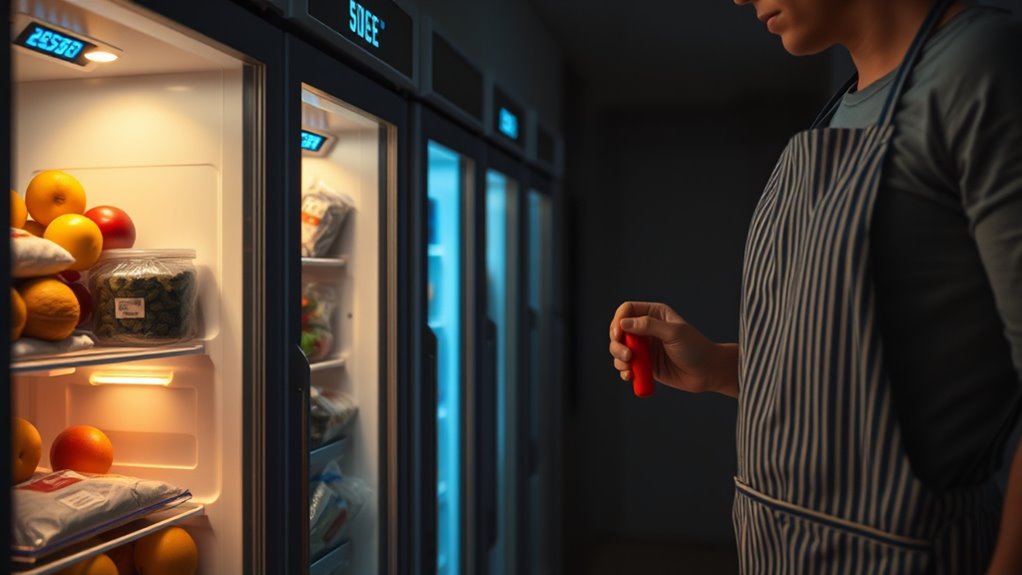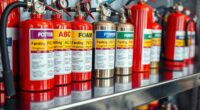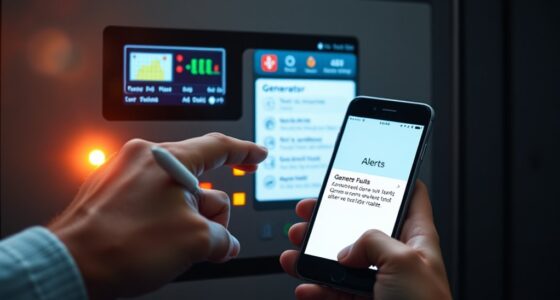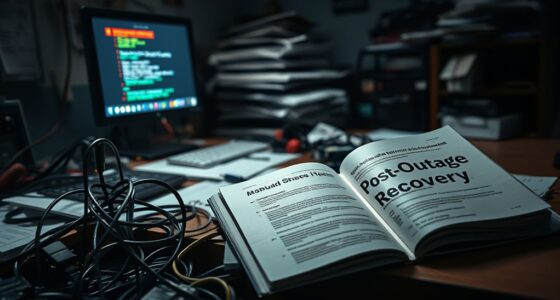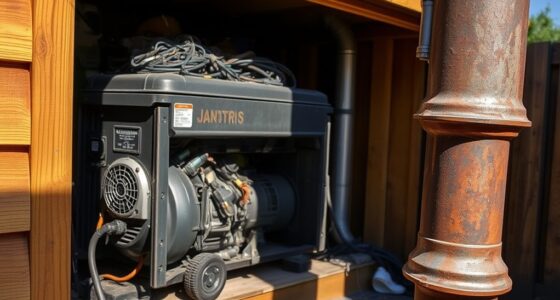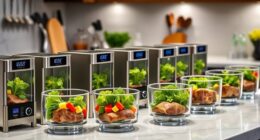During a blackout, prioritize your frozen foods first to keep them below 40°F; avoid opening the freezer often to retain cold. Next, focus on refrigerating perishable items like dairy and meat, closing the doors tightly after each access. Use insulated wraps or ice packs to extend cold storage, and implement quick cooling techniques if possible. Monitoring temperatures and evaluating food safety will help protect your supplies; continue exploring for additional tips to manage your fridge and freezer effectively.
Key Takeaways
- Keep doors closed as much as possible to maintain cold temperatures and prevent spoilage.
- Use ice packs or dry ice to bolster freezer cold retention during outages.
- Prioritize storing and retrieving high-perishability foods first to reduce spoilage risk.
- Continuously monitor temperatures with reliable thermometers to assess food safety status.
- Replenish and reorganize perishables promptly once power is restored to ensure safety and minimize waste.
Assessing Your Food Inventory and Priorities

To effectively prioritize your food during a blackout, start by taking stock of your inventory. Keep a detailed, current list of all perishables and non-perishables in your fridge and freezer, including quantities, purchase dates, and expiration or use-by dates. Categorize foods by perishability: high-risk items like meat, dairy, and seafood; moderately perishable items such as fresh produce; and low-risk foods like canned goods and frozen meals. Label foods clearly with purchase and opening dates to track their shelf life. Organizing foods within your storage units by priority and perishability can help reduce door openings and minimize spoilage. Additionally, link your inventory to a meal plan to guide your prioritized consumption and prevent unnecessary waste. Incorporating storage organization strategies can further improve accessibility and reduce spoilage during outages. Properly understanding food spoilage signs can help you make informed decisions about what to discard and what remains safe to consume. Being aware of food safety guidelines is especially important for perishable foods, as improper handling can lead to foodborne illnesses during extended outages.
Implementing Immediate Cooling Strategies
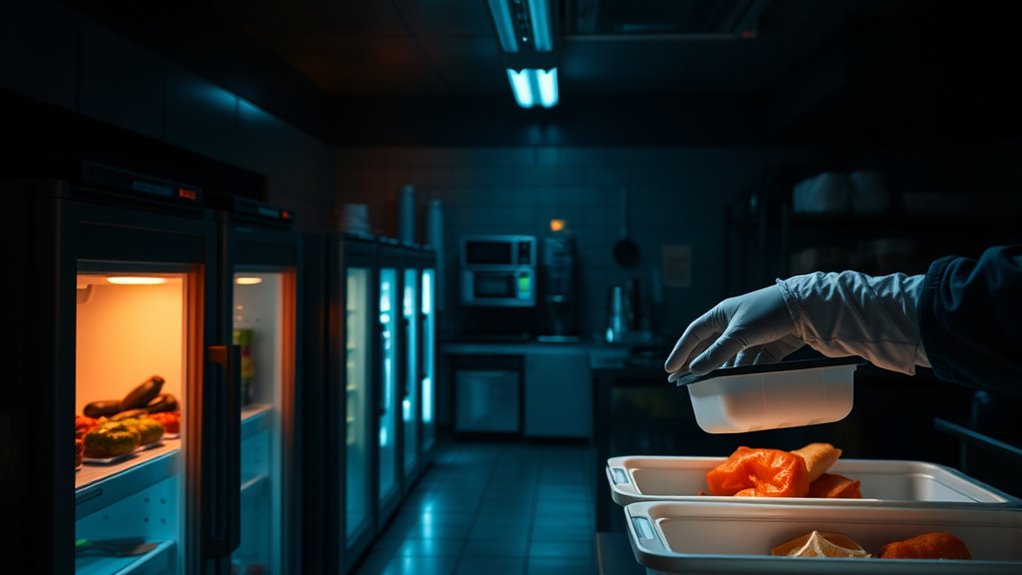
When power goes out, acting quickly to cool your food can prevent spoilage and reduce waste. Use dry ice to rapidly lower temperatures in your freezer—fifty pounds can keep an 18-cubic-foot freezer cold for about two days. Handle dry ice with gloves and in well-ventilated areas to avoid CO₂ buildup. Supplement cooling with frozen water or gel packs inside your refrigerator and freezer to extend safe storage times. Place ice or blocks of ice in units to keep temperatures below 45°F. Shift perishable items to coolers or ice chests if outages last beyond four hours. Monitor temperatures regularly, and avoid opening doors unnecessarily to conserve cold air. Immediate, strategic cooling helps maintain food safety until power is restored. Silky tantrums often occur, adding humor to shoots. Additionally, understanding the effectiveness of HEPA filtration of your cooling methods can help you choose the most effective solutions for rapid temperature reduction. Proper insulation and sealing of your refrigeration units can also improve efficiency during outages, ensuring temperature stability and preventing spoilage.
Managing Refrigerator and Freezer Doors Effectively

To keep your food safe during a blackout, you need to manage your refrigerator and freezer doors carefully. Keep doors closed as much as possible and avoid opening them unless necessary, to prevent cold air from escaping. Plan your meal access so you can get what you need quickly, reducing door openings and helping your food stay cold longer. Maintaining a consistent temperature within your appliances is essential to prevent spoilage and ensure food safety during extended power outages. Additionally, monitoring the storage capacity of your freezer can help you prioritize which items to consume first, minimizing waste. Regularly checking the air circulation inside your freezer can also improve efficiency and keep items frozen longer. Understanding water quality and how it can affect appliance performance might help you identify issues that could compromise your food preservation efforts. Being aware of power restoration times can also aid in planning your appliance management more effectively.
Keep Doors Closed
Keeping refrigerator and freezer doors closed during a blackout is essential for maintaining safe temperatures and preventing food spoilage. Refrigerators can keep food safe for about four hours if doors stay shut, while full freezers can last around 48 hours, and half-full freezers about 24 hours. Each time you open a door, cold air escapes, causing temperatures to rise faster and increasing spoilage risk. To maximize cold retention, group items before opening, use flashlights to avoid unnecessary door openings, and keep a thermometer inside to monitor temperatures without opening doors. Filling freezers with ice packs and arranging items tightly also helps retain cold. Remember, avoiding door openings is the most effective way to delay temperature rise and keep your food safe during outages. Additionally, utilizing proper insulation techniques can help extend the cold preservation period during power outages. Incorporating advanced insulation materials can further improve your freezer’s ability to maintain low temperatures for longer periods. Employing smart temperature monitoring devices can also alert you promptly if temperatures rise beyond safe levels. Implementing these strategies, along with regular maintenance of your appliances, can further enhance their efficiency during power disruptions.
Minimize Opening Frequency
Limiting how often you open your fridge and freezer during a blackout can considerably extend the time your food stays safe. Each door opening releases cold air, causing internal temperatures to rise and speeding up spoilage. Refrigerators typically keep food safe for about four hours unopened, while full freezers can last up to 48 hours, half-full about 24 hours. To minimize temperature fluctuations, prepare a list of needed items beforehand and only open the door when necessary. Avoid browsing or searching inside during the outage. Use external containers or trays to gather multiple items at once and quickly return them. Organizing food so that frequently used items are easy to find, reducing door opening frequency and keeping temperatures stable longer. Incorporating proper placement of your refrigerator can also help maintain consistent internal temperatures for longer periods during a blackout. Additionally, ensuring good insulation around your freezer can help preserve cold temperatures even when power is lost. Proper storage techniques can further enhance the effectiveness of insulation and temperature retention. Implementing temperature monitoring devices can also help you keep track of internal conditions and respond accordingly.
Plan Meal Access
Organizing your refrigerator and freezer for easy access can make a significant difference during a blackout. Designate a specific area for frequently used essentials like milk, eggs, and medications to minimize door openings. Group similar items together and place those needed first at the front, with less urgent foods toward the back, reducing search time. Use clear containers or labels to identify contents quickly. Keep raw meats on lower shelves to prevent cross-contamination. Prepare meal portions in advance to limit door openings during mealtime, and prioritize consuming highly perishable foods first. Store ready-to-eat items separately for quick access. Planning meals around cooler access times helps conserve energy. This approach ensures you maximize the longevity of your food and maintain safety during power outages.
Monitoring Temperatures and Identifying Safe Foods
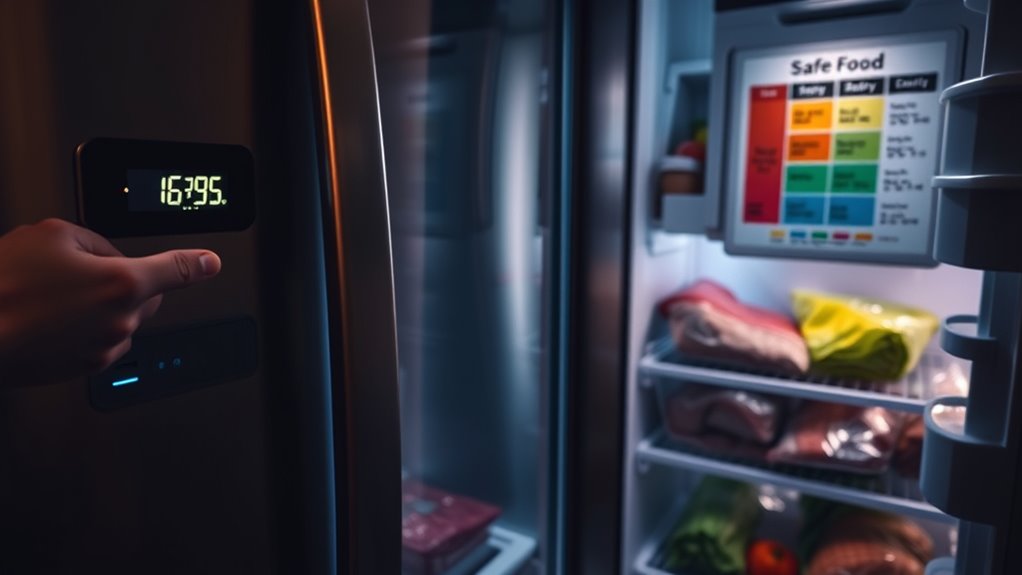
You should regularly check food temperatures with a reliable appliance thermometer to guarantee safety. Recognizing signs of spoilage, like bad odors or discoloration, helps you identify unsafe foods quickly. Keeping track of temperature readings and visual cues allows you to make informed decisions during a blackout.
Use Appliance Thermometers
Appliance thermometers are essential tools for monitoring temperatures inside your refrigerator and freezer, especially during blackouts. They come in various types, such as wireless models that offer remote updates up to 30 feet away and wired probes for direct internal readings. Flexible options like magnetic or suction cup thermometers help position sensors ideally. Digital thermometers with large displays show current, minimum, and maximum temperatures at a glance, while some include alarms that alert you when temperatures go outside safe ranges. Features like programmable alarms, battery indicators, and waterproof designs improve dependability. Position sensors near high-risk foods like meats and dairy. Use thermometers with clear displays for quick readings in low-light conditions. Accurate monitoring guarantees you can make informed decisions about your food safety during power outages. Sector performance metrics are also valuable for understanding the stability of your storage environment and potential risks to food safety during extended outages.
Check Food Temperatures
During a blackout, regularly checking the temperatures of your refrigerated and frozen foods is crucial for ensuring their safety. You should check all food temperatures every 2 hours to see if they stay within safe limits. Record your readings along with the time to create a safety log. Cold food should stay at 41°F (5°C) or below; above this, bacteria multiply rapidly. If food exceeds 41°F for more than 2 to 4 hours, discard it to prevent illness. Use temperature data to determine if foods can be safely cooked or refrozen. Pay close attention to freezer temperatures, especially as they thaw. Remember, even if food looks or smells normal, extended exposure to the Temperature Danger Zone increases health risks. Accurate temperature checks are essential for making safe decisions. Additionally, keeping track of your food safety efforts is important; support hours can provide assistance if you experience extended outages or need guidance on handling emergency situations.
Recognize Safe Signs
Since visual and physical signs can be unreliable indicators of food safety, it’s essential to learn how to recognize safe foods without solely relying on temperature checks. Look for ice crystals in frozen foods; their presence suggests the food is likely safe to refreeze or cook. Discard any packages that are bulging, leaking, or have damaged seals, as these indicate spoilage. Foods exposed to floodwater or moisture in non-waterproof containers should be thrown out. If a food spurts liquid or foam when opened, it’s spoiled and unsafe. Use appliance thermometers to confirm temperatures—frozen foods should be at or below 0°F, and refrigerated items at or below 40°F. Always discard foods that smell, look, or feel abnormal, regardless of temperature, to prevent foodborne illness.
Using Food Safety Guidelines for Post-Blackout Decisions
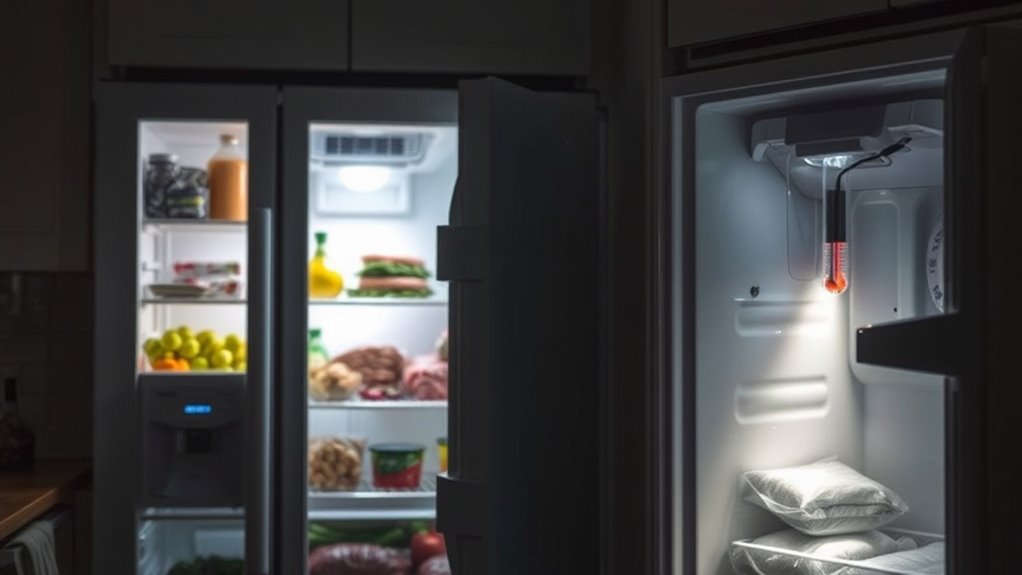
After a blackout, making safe decisions about your food requires careful assessment based on established guidelines. Use a thermometer to check freezer temperatures; foods are safe to refreeze if below 40°F. Discard perishable refrigerated items that have been above 40°F for over 4 hours. Don’t rely on appearance or smell alone—pathogens can develop without visible signs. When in doubt, throw out questionable foods to avoid illness. Remember, partially thawed foods with ice crystals or at 40°F or below can be cooked or refrozen safely.
After a blackout, check temperatures carefully and discard any foods above 40°F for over 4 hours to stay safe.
- Check freezer temperatures regularly with an appliance thermometer
- Discard perishable foods held above 40°F for more than 4 hours
- Cook or refreeze foods at or below 45°F promptly
- Avoid refreezing thawed foods that exceeded safe temperature duration
- Discard items contaminated by flood or stormwater during outages
Planning for Replenishment and Long-term Preservation
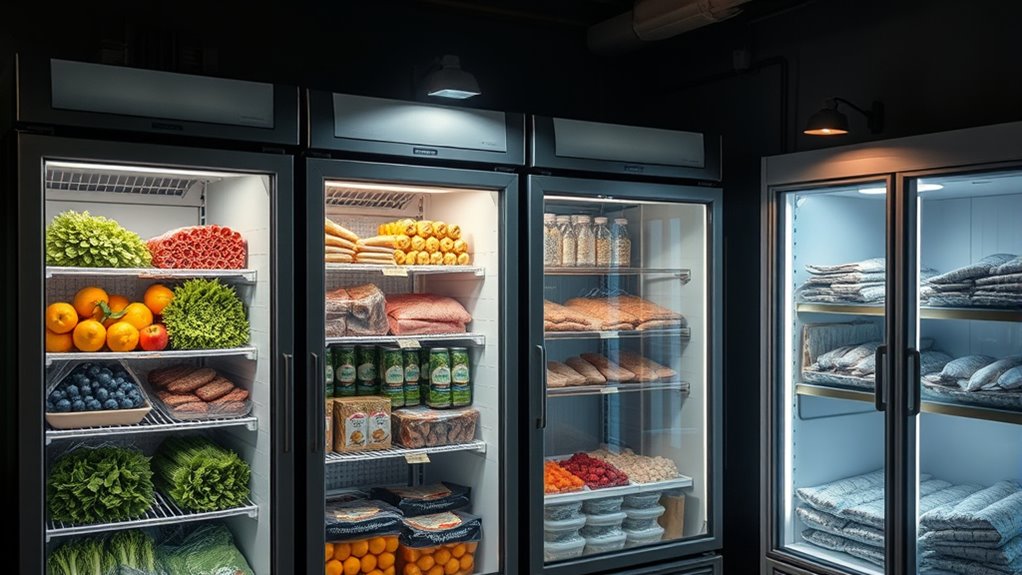
Effective planning for replenishment and long-term preservation starts with prioritizing perishable foods like meat, dairy, and leftovers that must stay below 40°F to prevent spoilage. Use appliance thermometers to monitor fridge and freezer temperatures during and after blackouts, helping you decide if foods are safe to refreeze or consume. Check for ice crystals or internal temperatures at or below 40°F to assess safety. Items above 40°F for over four hours are unsafe and should be discarded. Keep detailed records of your food inventory to facilitate quick decisions on what to replenish first. To extend shelf life, learn traditional preservation methods like dehydration, canning, and fermentation. Stockpile canned goods and rotate supplies regularly to maintain freshness, reducing reliance on refrigeration during extended outages.
Frequently Asked Questions
How Long Can I Safely Keep Food Without Power Before It Spoils?
You can safely keep refrigerated food for about 4 hours without power if you keep the door closed. After that, perishable items like meat, eggs, and leftovers should be discarded to prevent foodborne illness. Frozen foods stay safe for up to 48 hours if the freezer is full and unopened. To maximize safety, avoid opening doors unnecessarily and consider adding ice if outages last longer.
What Are the Signs That Frozen Foods Are No Longer Safe to Eat?
You can tell frozen foods are unsafe if they have large ice crystals or a slushy texture, indicating thawing and refreezing. Melted water or softening shows spoilage, and any thawed meat with blood or liquid should be disposed of. Off-odors like sour smells also signal spoilage. If the food lacks ice crystals and feels warm, it’s best to discard it to prevent illness. Always check temperature and appearance to ensure safety.
Can I Refreeze Thawed Food After a Blackout?
Wondering if you can refreeze thawed food after a blackout? Yes, you can, but only if the food stayed cold enough—below 41°F—and ice crystals remain. If it was above that temperature for more than two hours, discard it to avoid illness. Keep the freezer door closed as much as possible, and check temperatures with a thermometer. Refreeze only if safety conditions are met, but expect some quality loss.
How Do I Prioritize Which Foods to Save First?
You should prioritize saving perishable foods like meats, seafood, dairy, and leftovers first, especially those still partially frozen or with ice crystals. Consume these quickly to prevent spoilage. Next, focus on foods that have been above 40°F for over 2 hours or show signs of spoilage—discard them. Items with longer shelf life, like canned goods and dried foods, can wait. Keep cold foods cold and avoid opening the fridge or freezer unnecessarily.
What Should I Do if My Freezer Is Only Partially Frozen After a Blackout?
Think of your freezer like a treasure chest—if it’s only partially frozen, you need to act quickly. Check for ice crystals or cold spots; if it’s still at or below 4°C, your food might be safe, and you can refreeze or cook it. But if it’s above that for over two hours, discard it. Use a thermometer, and prioritize consuming or cooking perishable items first.
Conclusion
When the power flickers out, think of your fridge and freezer as guardians of your pantry’s heart. By acting swiftly, you shield your food’s freshness and your family’s safety, turning a crisis into a stand of resilience. Trust your instincts, stay vigilant, and treat your food like precious treasures. With careful planning and quick action, you’ll weather the blackout storm and emerge stronger, your nourishment preserved like a beacon of hope in the darkness.

